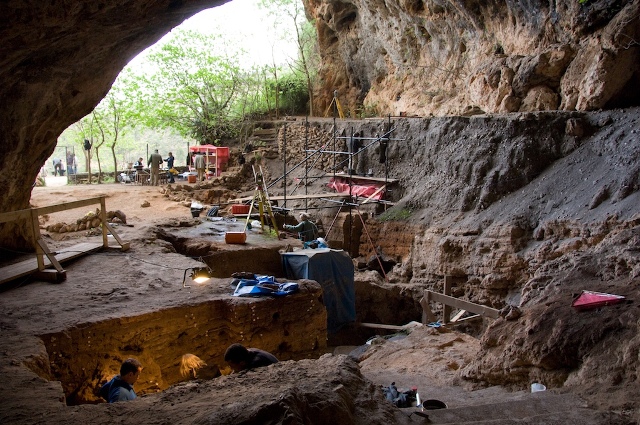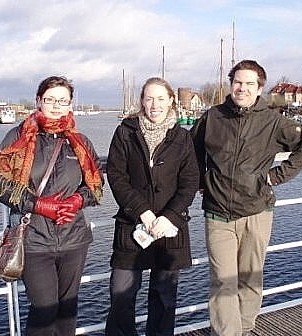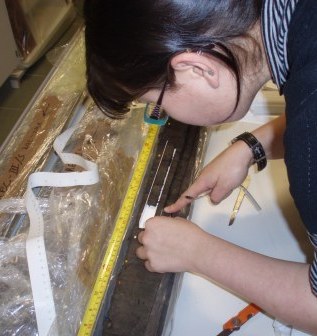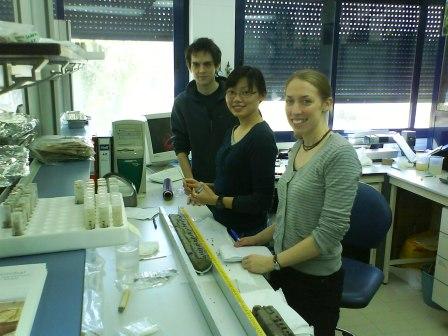News
December 2009
WP-4 Conference Report
Emma Tomlinson traveled to San Francisco in December to present some of WP-4s recent work to the AGU fall meeting. Firstly, a poster titled: ‘Micro analysis of tephra by LA-ICP-MS – strategies, advantages and limitations’, documenting our work into optimizing data quality during trace element analysis. Secondly, a paper on: ‘The Campanian Ignimbrite and its precursor eruptions – implications for tephrochronology’. AGU is a huge conference, with more than 16,000 participants, so provided a large and interested audience.
October 2009
WP-3 Conference Report
Rupert Housley attended the eighth meeting of the Union Internationale des Sciences Pré-et Protohistoriques (UISPP) Commission XXXII: the final Palaeolithic of the Great European Plain. The workshop was held in the University of Copenhagen between 13-16th October. A paper entitled 'the potential of volcanic tephras in the European late Palaeolithic' was presented at the meeting.
September 2009
WP-1 Fieldwork in Greece
Dustin White
WP-1's final sampling campaign of the 2009 field season took place in mid-September as part of a research collaboration with the Ephoreia of Palaeoanthropology and Speleology of Southern Greece in Athens. Along with geoarchaeologist Panagiotis (a.k.a. Takis) Karkanas, RESET member Dustin White collected systematic sediment samples for distal microtephra analysis from three Middle-Upper Palaeolithic sites in the Peloponnese and Thessaly regions of Greece, namely Lakonis Cave I, Klisoura Cave 1, and Theopetra Cave.
(Above): Map of WP-1's 2009 sampling sites in the Balkans
Lakonis Cave I is an east-southeast facing collapsed karstic cave system exposed along the north-eastern coast of the Mani peninsula near the town of Gythion in the southern Peloponnese. The site has been under active investigation since 1999 by a team led by Eleni Panagopoulou and preserves a deep (c. 7 m) sequence of Middle Palaeolithic and Initial Upper Palaeolithic deposits with a high density of archaeological remains and numerous hearth features. Excavation and sample collection at the site is particularly challenging as the stratigraphic sequence is strongly lithified with calcitic cement.
(Left): Lakonis Cave I. Photograph courtesy of Eleni Panagopoulou
(Right): Takis Karkanas (foreground) & Eleni Panagopoulou sampling lithified late Middle-Initial Upper Palaeolithic deposits at Lakonis Cave I
Klisoura Cave 1 is a deeply stratified, south-east facing rock shelter located in a limestone gorge at the northern edge of the Argive Plain in the eastern Peloponnese. From 1994-2007 systematic site excavations directed by Margarita Koumouzelis uncovered a rich archaeological record spanning the Middle Palaeolithic to Mesolithic periods. The site contains a very high density of archaeological remains, including abundant lithics, diverse fauna, and numerous clay hearths and combustion features. Of particular interest are the recovered arched backed blade assemblages reminiscent of the Uluzzian of Italy, a so-called "transitional industry". Microtephra sampling focused on the late Mousterian, Early Upper Palaeolithic (i.e. Uluzzian) and Aurignacian levels at the site.
(Left): The rock shelter of Klisoura Cave 1. Photograph courtesy of Takis Karkanas
(Right): West sampling profile of Klisoura Cave 1. Photograph courtesy of Takis Karkanas
Theopetra Cave is located on the steep north-facing side of a limestone rock formation near the town of Kalambaka at the north-western edge of the Thessaly Plain in central Greece. From 1987-2007 systematic excavations at the site led by Nina Kyparissi-Apostolika revealed a complex sequence of stratified deposits up to 6.4 m in depth ranging in age from the Middle Palaeolithic to Neolithic periods. While Palaeolithic artefacts are comparatively low in density across the site, distinct occupation levels have been identified throughout the late Middle and early Upper Palaeolithic sequence, which was the focus for microtephra sampling. With EU funding, the site has recently been turned into a tourist attraction for the area.
(Left): The Theopetra rock formation, viewed from the northwest
(Right): The interior of Theopetra Cave
Lastly, during this sampling trip to Greece there was an opportunity to visit Franchthi Cave in the eastern Peloponnese where excavations in the 1970's uncovered evidence of a distinct tephra layer near the base of the sequence, later sourced to the Campanian Ignimbrite Y5 eruption. While the site in no longer under excavation and there is currently no access to the original section profiles, WP-1 has recently acquired an archived sub-sample of the Franchthi tephra from the original director of site excavations, William Farrand. Further analyses of these data will complement the broader project goals of characterising the chemical variability and taphonomic contexts of the CI across Europe and the eastern Mediterranean.
(Above): view of Franchthi Cave
August 2009
WP-3 Fieldwork in Poland, part 2
Clive Gamble and Rupert Housley
Two months after the previously reported trip to Poland WP-3 undertook a second longer visit to sample several open-air localities for microtephra. The first point of investigation was Węgliny, an Ahrensburgian site in the district of Gubin in southwest Poland previously investigated by Mirek Masojć. With only limited on-site sampling opportunities, we focused our attention on an adjoining tract of low-lying land containing peat and gyttja from where, with the help of Mirek Masojć and two assistants, a promising set of organic cores were taken covering nearly 6 metres. These cores, believed to include at least part of the Lateglacial, will help to link our research with that of WP-6.
(Left): Organic gyttja as sampled by Russian peat corer from peat bog at Węgliny;
(Right): Sampling tin in profile at Dzierżysław 35 showing fossil soil / Magdalenian activity layer (1a) and underlying loess layer (2)
Next sampling site was Dzierżysław 35, also in Silesia, where previous excavations had highlighted the existence of a rich Magdalenian assemblage. Assisted by Marta Połtowicz-Bobak, Darek Bobak and several students, we were able to pin-point the relevant part of the stratigraphic sequence and take samples. Our visit to Dzierżysław 35 coincided with excavations of a neighbouring open-air Szeletian site - Lubotyń 11, which is notable for its rich lithic assemblage, in-situ hearths and 14C dates. We used the opportunity to collect samples for microtephra on behalf of WP-1.
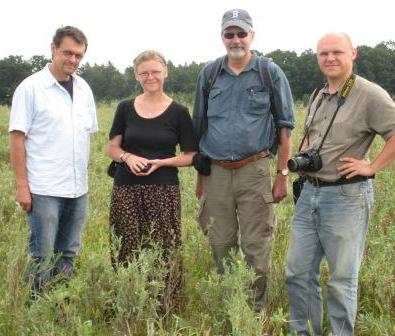
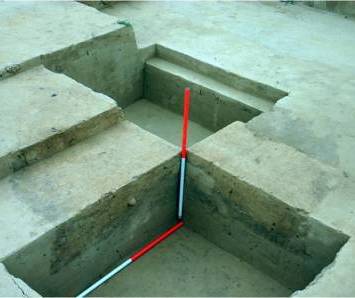
(Left): Andrzej Wisniewski, Marta Połtowicz-Bobak, Clive Gamble and Darek Bobak at Sowin 7
(Right): The Magdalenian 'feature' as excavated at the site of Mały Gawroniec, Ćmielów district
Concurrent with the aforementioned sampling, Andrzej Wisniewski and colleagues were undertaking archaeological investigations at Sowin 7, another Silesian site with a large number of Magdalenian and epi-Gravettian lithics. Microtephra samples were taken here also.
WP-3 then moved to the Sandomierz region of eastern Poland to sample two Magdalenian sites in the Ćmielów district (Swietokrzyskie voivodship): Mały Gawroniec (i.e. Ćmielów 95) and Podgrodzie 16. Here we were expertly assisted by a team from Warsaw led by Michał Przeździecki. Both sites are located on the northern edge of the Opatowsko-Sandomierski loess region and have two preserved palaeosols believed to date to the Allerød and Bølling periods.
WP-1 Fieldwork at Les Cottés, France
Les Cottés in west-central France is the latest site investigated as part of the RESET WP-1 2009 sampling programme. The cave is located along the Gartempe River in the Seuil du Poitou region and preserves a rich archaeological sequence spanning the Middle-Upper Palaeolithic 'transition'. Along with colleague Marie Soressi, Dustin White collected high-resolution sediment samples for distal microtephra analyses from the stratified Chatelperronian and earliest Aurignacian levels at the site. Archaeological data recovered at Les Cottés over the past few years have provided important new evidence for the last Neanderthals and earliest anatomically modern humans in Western Europe.
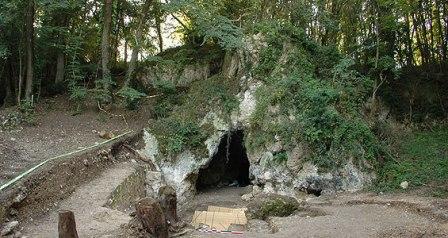
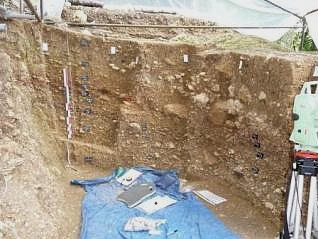
(Left): Les Cottés, a late Middle to early Upper Palaeolithic site in west-central France. Photo courtesy of Marie Soressi.
(Right): North Profile of the 2009 excavations at Les Cottés. Microtephra sampling columns located at far left.
WP-1 Fieldwork at Kozarnika Cave, Bulgaria
Kozarnika Cave in northwest Bulgaria preserves one of the longest and most important archaeological records known from the Balkans. The site is located near the Serbian border in the northern foothills of the Western Balkan Range approximately 30 km from the Danube River.

(Above): Kozarnika Cave (top centre) and the Danubian Plain (top right) in northwest Bulgaria. Photo courtesy of Alain Queffelec.
The karstic cave contains at least 21 geological layers with cultural complexes spanning the Lower, Middle and Upper Palaeolithic to the Neolithic, Bronze Age and more recent periods. Along with colleagues Nikolay Sirakov (Bulgarian Academy of Sciences-National Institute of Archaeology at Sofia) and Catherine Ferrier (University of Bordeaux I, CNRS), RESET member Dustin White collected high-resolution sediment samples from the rich and well preserved late Middle to early Upper Palaeolithic levels at the site for distal microtephra analysis.
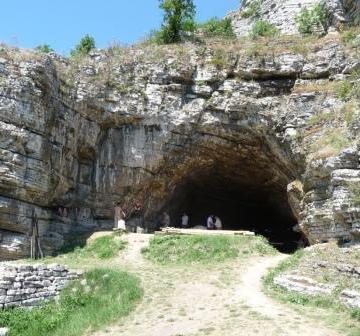

(Left): Entrance to Kozarnika Cave (Right): Nikolay Sirakov and Catherine Ferrier inside Kozarnika Cave
In addition, short reconnaissance trips were made to Temnata and Bacho Kiro caves located approximately 130 km and 230 km east-southeast of Kozarnika, respectively. At Temnata Cave 16, sediment from the known 'tephra layer' was collected for preliminary geochemical analysis and potential lateral cross-correlation with identified tephras from other geological and archaeological sites across southeast Europe. More systematic sampling at Temnata is planned during the 2010 field season. Unfortunately, remaining unexcavated sediments at Bacho Kiro were largely destroyed in 2001 during severe flooding near the cave entrance, and what is left of deposits at the site today are generally non-representative of the original stratigraphic context. The late Middle Palaeolithic site of Mussielevo, preserved in a loess sequence on the Danubian Plain approximately 170 km east of Kozarnika, is also being considered as a possible RESET sampling locality in 2010.
July 2009
WP-6: Sub-sampling a new Padul core sequence from Granada, Spain
Mark Hardiman
Between the 13th and 19th of July Mark Hardiman (PhD student, RHUL) visited Professor Trino Torres and Dr José Ortiz at the Madrid School of Mines, Universidad Politcnica de Madrid to sub-sample a new sequence taken from the Padul peat bog. This site contains one of the few long terrestrial pollen and isotopes records available from southern Spain and thus is a key target site for WP-6.
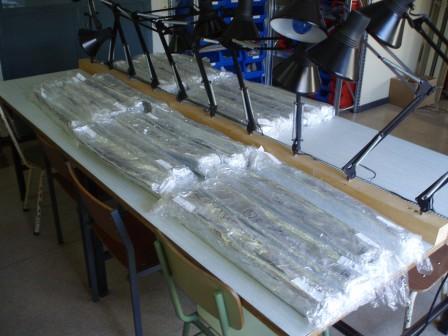
(
Left): cores from Padul peat bog awaiting sub-sampling for microtephra
Sub-samples were taken covering the RESET timeframe in the hope that this site should provide information on any possible tephra distribution into southern Spain during this time. If it does then the site will provide an invaluable record for WP-1 who are intending to sample a number of southern Iberian late Middle and early Upper Palaeolithic archaeological sites.
WP-1: Fieldwork at L'Arbreda Cave in Catalonia, Spain
Dustin White and Mark Lewis
L'Arbreda Cave in Catalonia, Spain was the focus of a recent WP-1 microtephra sampling trip conducted by Dustin White and Mark Lewis. The site forms part of the Prehistoric Cave Park of Serinyà (or the Caves of Reclau), which also includes Mollet and Reclau Viver caves.
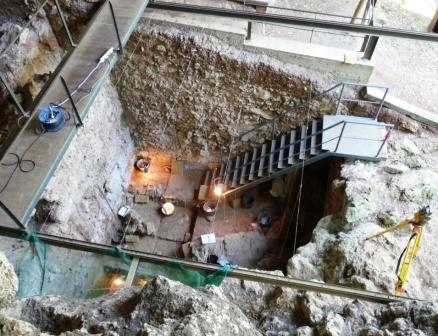
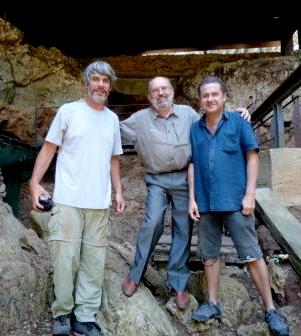
(Left): L'Arbreda Cave, an important late Middle-early Upper Palaeolithic site in Catalonia. (Right): Dustin White, Narcís Soler & Mark Lewis (from left to right) at L'Arbreda Cave
L'Arbreda Cave preserves one of the most complete stratigraphic and archaeological sequences in the region and provides important information related to cultural changes spanning the Middle-Upper Palaeolithic. Excavations at the site, led by Dr Narcís Soler from the University of Girona, have recovered evidence which suggests a very abrupt local shift from the late Mousterian to the earliest Upper Palaeolithic occupation of the site, highlighted by an early presence of an 'Archaic' Aurignacian industry (c. 38,300 14C years BP). L'Arbreda thus holds great significance to debates surrounding the last Neanderthals and earliest Anatomically Modern Humans in Mediterranean Western Europe.
WP-1: Fieldwork at Grotte Mandrin in south-western France
Dustin White and Mark Lewis
WP-1 members Dustin White and Mark Lewis recently returned from sampling for distal microtephras at the site of Grotte Mandrin in the Rhône Valley of south-western France.
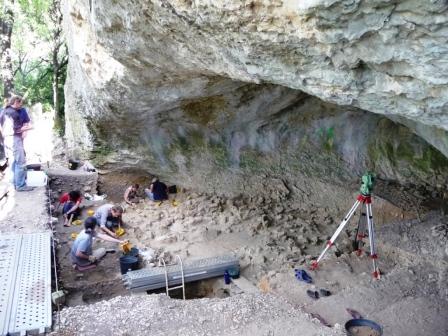
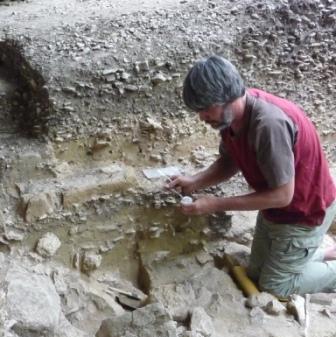
(Left): Excavations at Grotte Mandrin, an important Middle-Upper Palaeolthic 'transition' site in the Rhône Valley, France. (Right): Dustin White sampling for distal microtephras at Grotte Mandrin.
The site, currently being excavated by a team led by Dr Ludovic Slimak, contains a stratigraphic sequence over 2 m deep with seven discrete archaeological levels spanning the late Middle and earliest Upper Palaeolithic periods. The rich archaeological and palaeontological assemblages uncovered to date shed new light on the dynamic relationships between late Mousterian, 'Transitional', and early Aurignacian industries in Mediterranean France.
WP-4 & WP-6: Fieldwork in Turkey
Emma Tomlinson and Christine Lane
Emma Tomlinson and Christine Lane visited Turkey for the dual purpose of sampling <80 ka deposits from the Acigöl and Golçuk volcanic centres, and of coring the Acigöl maar to look for both local visible tephra layers and microtephra from local and distal volcanic centres. The trip was organised by Erkan Aydar and coring was undertaken by Mehmet Ekmekçi, both from Hacettepe University.
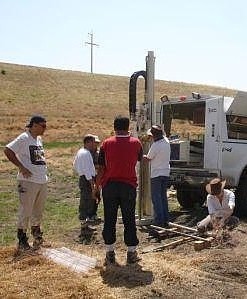

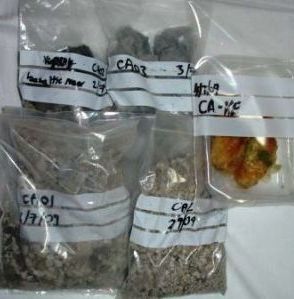
The Acigöl volcanic complex is situated in central Anatolia, amid the stunning volcanic landscape of Cappadocia (photo below). Thick ignimbrite deposits were erupted in pre-caldera and caldera-forming eruptions during the Quaternary. These have eroded into distinctive conical, pointed, columnar, mushroom and be-hatted ‘fairy chimneys’ by winds and floodwater. The region has provided a centre for civilisations for millennia. 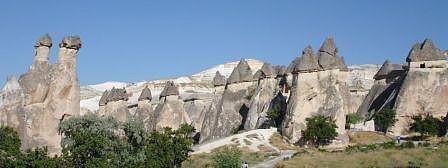 WP-4 is interested in the more recent intra-caldera activity of the Acigöl complex, the products of which are potentially important for dating eastern Mediterranean and south-eastern European marine cores and archaeological sites. We sampled several maars and associated rhyolite domes [Kocadag (~70 ka), Guneydag (12-20 ka), Korudagi (~16 ka)] which are relevant to RESET.
WP-4 is interested in the more recent intra-caldera activity of the Acigöl complex, the products of which are potentially important for dating eastern Mediterranean and south-eastern European marine cores and archaeological sites. We sampled several maars and associated rhyolite domes [Kocadag (~70 ka), Guneydag (12-20 ka), Korudagi (~16 ka)] which are relevant to RESET.
We then travelled west to Isparta, to sample Golçuk, with the aid of Evren Çubukçu (Hacettepe University). The Golçuk maar is 2.5 km wide and associated tephra deposits have a maximum thickness of 100-150m, made up of phreatoplinian surges and falls. Recent volcanic activity at the maar has been dated to between 72.7 and 24 ka.
The samples collected in the field compliment those already received from the volcanoes Erciyes (~10 ka) and Nemrut (~80 ka and <10 ka), providing a broad archive of the explosive Turkish volcanism within the RESET timeframe.
WP-4: Ciomadul volcano (35-40 ka), southern Carpathians, Romania
Martin Menzies
Ciomadul, in the southern Carpathians, is the most recently active volcano in the calc-alkaline volcanic belt of Romania which has evolved over the last 9 Ma. Volcanologist Nino Seghedi (Geodynamics Institute, Bucharest) guided me during a two day visit to Ciomadul.
The volcanic history of the region started with the formation of domes ca. 200 ka ago. This was followed by a volcanic hiatus of ca.100-150 ka. At some unknown time a phreatomagmatic eruption through the middle of the dome complex produced the Mohos maar crater with intra-caldera base surge deposits (exposed on the crater wall) and possibly pumice fall and debris flows. This now exists as the older, shallower, Mohos crater filled with a 10 m peat bog which has been the focus of pollen studies. After a period of time an eruption from the St Ana crater generated a buoyant subPlinian column from which pumice fall deposits were produced and column collapse generated the overlying pyroclastic flow deposits.
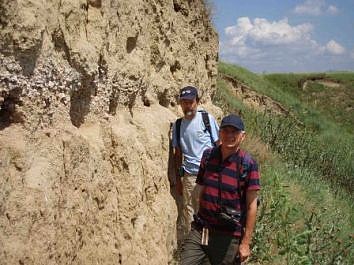

(Photo Left): Nino Seghedi (front) and Alex Szakacs on distal (reworked) fall 40 km from Ciomadul volcano
(Photo Right): Diorama showing Neolithic activity on Fortress Hill (a volcanic dome) from where such remains have been studied
A fall unit from St Ana crater [2 km south of Baile-Tusnad] has been dated using 14C methods. Organic material in palaeosols [underlying the fall deposits] and charcoal in the uppermost part of the overlying flow deposits yielded ages of 35.6-42.65 ka. This is complicated by the report of 10 ka charcoal toward the top of the flow deposit. This more recent history is supported by pollen analysis of cores from Mohos crater which points to an age of ≤9 ka for the crater fill.
At Mohos crater samples were collected from the intra-crater surge beds and a debris flow. These low density clasts were found to be only slightly vesicular and appeared miarolitic to stretched in external appearance. At St Ana crater, the 35-42 ka fall deposit was sampled immediately above the paleosol and immediately below the pyroclastic flow deposit. Distal equivalents of this eruption some 40 km from the craters were studied but most of the material had been reworked and was deemed unsuitable for RESET purposes.
The fall deposits are in the correct time window for RESET but the extent of the fall footprint is unknown, probably measured in hundreds of km. As such these eruptions are important in the context of archaeological issues (<40 ka) in Bulgaria-Romania. However the widespread occurrence of Campanian Ignimbrite in Romania has implications for larger scale correlations.
June 2009
WP-3: Sampling an archived U-channel from Dourges, Nord-Pas-de-Calais, France
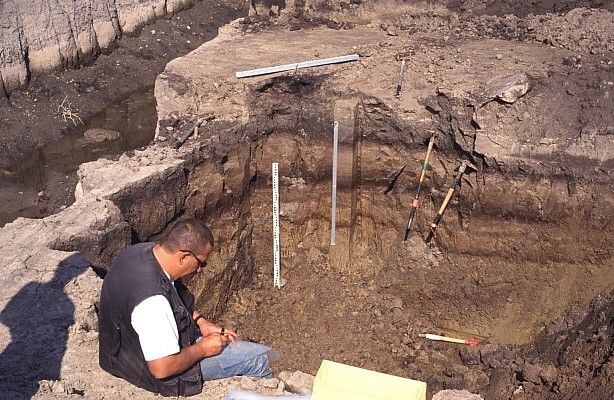
In 2000 and 2001 a series of rescue investigations were undertaken near the town of Dourges in the Nord-Pas-de-Calais region of north-eastern France in advance of construction work connected with modern economic development. The field investigations uncovered a surviving Lateglacial sedimentary sequence with associated Magdalenian and Federmesser archaeology (including lithics and worked bone artefacts) and well-preserved malaeocological and vertebrate faunal remains (for an account of the work, see the paper by Deschodt et al., 2005.
Quaternaire 16, 229-252).
In 2009, with the assistance of Pierre Antoine (UMR CNRS 8591 - Laboratoire de Géographie Physique - "Environnements quaternaires continentaux, dynamique naturelle et anthropisation") and with agreement from L. Deschodt - the leader of the earlier investigations on the site, RESET has successfully secured a contiguous series of sub-samples for microtephra analysis from an archived 1 m U-channel (B3) that preserves an accurate record of this important Lateglacial sequence. Within the sampled column there are three prominent organic horizons (lower "HTI", middle "HTM" and upper "HTS": visible clearly in the photograph -
right - which was taken when the U-channel was removed) and a series of intervening tufaceous silts. The whole sequence is known to span the period of the Bølling and Allerød interstadials.
(Photo Right):
The position of the U-channel is marked by the vertical tape in the centre of the photograph. (2001 image, courtesy of Pierre Antoine)
WP-6: Sub-sampling Lateglacial lacustrine records from Alpine and Lowland Slovenia
Christine Lane and Vicky Cullen visited Dr Maja Andric, at the Institute of Archaeology in Ljubljana, Slovenia, to take sub-samples of sediment cores from Lake Bled, in the Slovenian Alps and Na Mahu, in Ljuljansko Barje. Based on previously published work, both sites present early Holocene through Lateglacial sedimentary sequences that have undergone earlier detailed palaeoenvironmental investigation. It is hoped the sites will form an eastern extension to the Central European Lateglacial lake chronologies already built by members of WP-6. In this region there is the potential to find microtephra horizons from multiple volcanic centres, since Lateglacial tephra layers from the Eifel, Iceland and Italy are all been identified relatively nearby; these sites could provide the key which brings these chronologies together.
(Photo left): Christine Lane with Maja Andric at the site of the Na Mahu core, Ljuljansko Barje
(Photo right): Whilst at the Institute for Archaeology, Christine gave a presentation on microtephra research and the RESET project, to members of the Archaeology, Geography and Biology departments in Ljubljana University
WP-3 Fieldwork at Hłomcza site 1 (Sanok district, Sub-Carpathia Voivodship, Poland)
Rupert Housley
On 16th June Rupert Housley, together with Pawel Valde-Nowak (Uniwersytet Jagielloński, Instytut Archeologii, Kraków), Anna Muzyczuk (Muzeum Podkarpackie w Krośnie) and three other archaeological workers, opened a small 2 x 2 m trench on the site of Hłomcza in the Polish Carpathians. Situated on a terrace 15 m above the San River and 700 m from the current river-bed, earlier investigations of the site had revealed a Magdalenian assemblage comprising 158 flint implements (including 31 tools, of which 22 were burins; including tall forms and the characteristic Lacan-type). Previous TL determinations indicate that the infill to the oval pit from where the lithics were recovered probably dates to 13.5 ± 2 ka BP. Stratigraphically the artefact-bearing feature underlies a 15 cm thick palaeosol layer believed to represent the Bølling and/or Allerød. Based on these observations the on-site activity is thought to represent an early stage of Magdalenian expansion, coincident with Dryas I or early Bølling. The site has been interpreted as a (possibly seasonal) hunting settlement, however no faunal remains have survived due to the unfavorable soil conditions.
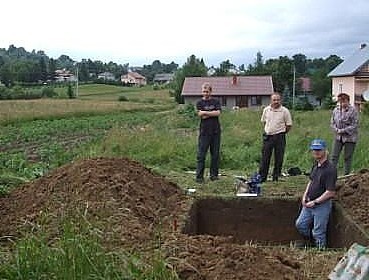
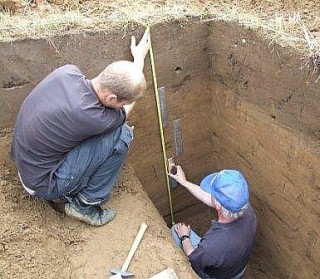
As part of RESET a total of 4 sampling tins were taken for analysis of potential microtephra. In the new trench no new Magdalenian lithics were recovered but a reasonable correlation was established between the previously-described sequence of deposits and the newly revealed stratigraphy. Later this summer WP-3 intends to make further visits to Poland to sample other Lateglacial archaeological sites.
WP-6: Sampling long terrestrial palaeoclimate sequences in Serbia and Croatia
Christine Lane
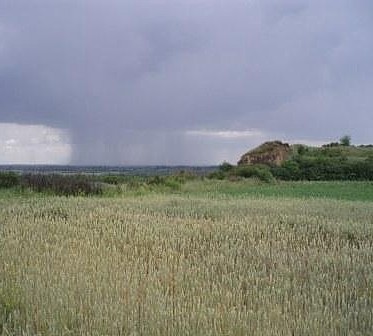
The Balkans provide an important location for distal microtephra studies in eastern and south-eastern Europe, as they form a semi-distal location for deposition of Italian volcanic ash. There also lies the potential to find tephra from Carpathian and Greek volcanic eruptions in this region. Visible tephra layers have been described in the long Upper Pleistocene loess-paleosol sequences of Serbia and Hungary (e.g.: Horváth, 2001; Buggle et al., 2009), indicating that large volcanic eruptions do reach this region and can be preserved in these widespread terrestrial climate archives.
(Photo right): The view from the Titel Loess Plateau, samples were taken (between showers!) from the loess outcrop visible in the right hand side of the image
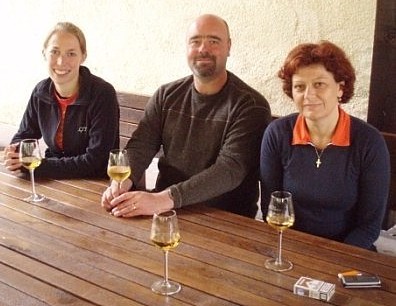
Simon Blockley and Christine Lane visited the loess-paleosol sequences of Vojvodina, Serbia and eastern Croatia to take samples for microtephra investigations. The sediment records in these areas extend >100 ka BP and samples were taken to cover a large part of the RESET timeframe. Under the guidance of Professor Slobodan Markovic, a long section through the Titel Loess Plateau was sampled. The Titel section provides a detailed and continuous palaeoclimate record, which records the glacial-interglacial transitions of the last glacial cycle. The focus of WP-6 will be to target deposits from known large eruptions throughout this long record, such as the Campanian Ignimbrite eruption, ~39 ka.
(Photo left): Sampling the local Croatian wine – grown in the best loess soils – with Lidija Galović
Dr Lidija Galović then helped with sampling of nearby Croatian loess-paleosol sequences. Despite the proximity of the two regions sampled, environments in the past were notably different. Higher precipitation and a greater influence of the Danube River in the Croatian area, is reflected by intensified paleosol formation and complex, often truncated, sequences. Samples were taken through two sections, targeting the last ~50 ka BP. As well as direct dating of the records, it is hoped that direct ties can be established between the palaeoclimate archives of these neighbouring regions, and to more distant areas, using tephrochronology.
May 2009
WP-5 Marine Core Sampling at Bremen Core Repository, Germany
Christopher Satow and Jennifer Stanford
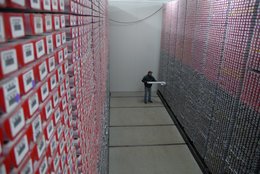
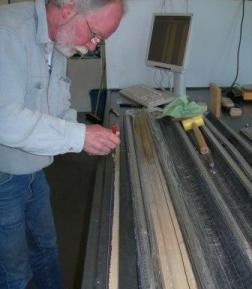
Between 9-22nd May Chris Satow (PhD student, RHUL) and Jennifer Stanford (postdoctoral research assistant, NOCS) visited the Bremen Core Repository at the MARUM centre, University of Bremen to sample ODP core 975. During the sampling they were kindly assisted by Walter Hale, Ursula Rohl and Vera Lukies. The core was run through the scanning XRF facility to gain first order compositional data, logged and photographed, and sub-sampled with U-channels. The sub-samples will be subjected to a multitude of proxy extraction procedures and, of course, processed for potential microtephra.
(Left): Bremen Core Repository in the MARUM centre, University of Bremen
(Right): Walter Hale overseeing U-channel sampling of ODP core 975
Core ODP975 originates from the sea bed of the western Mediterranean near the Balearic Islands. Potentially therefore, in combination with LC21 (a core from the Aegean Sea), this record could provide information about the synchronicity or otherwise of Mediterranean wide climatic (in particular hydrological) changes. It is hoped that ODP975 will also provide an invaluable complementary record for other RESET researchers working in neighboring areas like southern France, Spain and north-west Africa.
WP-4 Sampling the Green Tuff (45-50ka), Pantelleria Italy
Martin Menzies

Pantelleria is the southernmost RESET eruptive site that lies in the (extensional) Sicily Channel between Sicily and Tunisia and is world-renowned for the occurence of pantellerite - a peralkaline rhyolites. Panellerite is a black, obsidian-like rock which was traded and utilised in the Mediterranean probably since pre-Christian times. Giovanni Orsi (INGV Naples) has mapped Pantelleria over the last 20+ years and kindly organised our excursion around the island between May 25-29th as part of the NERC RESET Consortium. Seven localities were selected focusing on the pre- and syn-caldera volcanic evolution of the island. Since the time window for RESET is 10-100 ka we were especially interested in the eruption of the Green Tuff (50 ka marker tephra) which blankets the pre-existent volcano and hence a large part of the island. It provides a very convenient and obvious time horizon and can be identified from some distance due to its colour and unconformable stratigraphy. The stratigraphy around the Green Tuff (50 ka) can be interpreted to mean that the eruption was relatively short lived producing a laterally continuous ignimbrite and co-ignimbrite ash layer layer. Since 50 ka was a "low stand" period in the Mediterranean the Green Tuff eruption would have produced sub-aerial flows that must exist beneath the present sea-level so a considerable amount of erupted fall and flow volume is submarine in nature.
(Right): Green tuff (45-50 ka) with highly vesicular fiamme unconformable on pre-caldera volcanic rocks
(Below): View from Montagna Grande whose elevation is caused by recent uplift. In the foreground Monte Gibele (post-caldera vent) with the Cinque Denti caldera rim (Green Tuff centre) in the far distance
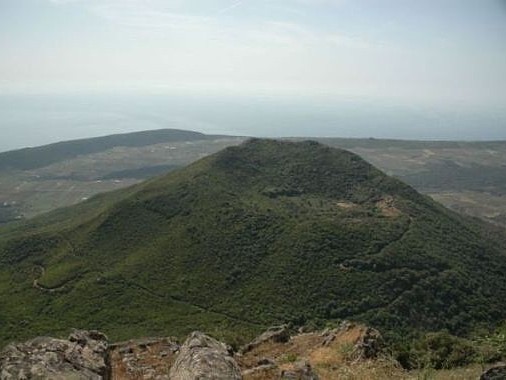
The pre-caldera (pre-50 ka) stratigraphy was studied to establish the frequency of major explosive eruptive events that might have dispersed tephra into archaeological sites and marine cores in north Africa (Libya and Tunisia) and the southern Mediterranean. Many of the pre-caldera pumice fall deposits were intimately associated with, and displayed gradational relationships with, underlying rheomorphic ignimbrites. The deposits at Scirafi were typical where the top of the exposure is an explosive deposit (i.e. clast supported pumice fall deposit) with a complete gradation to an effusive deposit (i.e. pantellerite with contorted flow banding). One can deduce that these were probably produced from low "hot" fountains similar to that observed on Mt Blanca (sub-Plinian eruption) on Tenerife. Much more explosive eruptions have happened on Pantelleria as evident from huge thicknesses of pumice fall deposit on the east of the island occurring at sea-level well below the Green Tuff. Thirty or so metres of pumice fall exists on the slopes above Balata dei Turchi, characterised by perfect cyclical,well-sorted, lithic-poor, pumice fall cycles that can be separated into three units by intervening thin paleosols. The lowermost unit was poorly exposed but comprised pumice layers beneath a talus/debris avalanche deposit. Above this the second unit comprised ~10-15 inversely graded pumice fall layers up to 2 metres thick. This could only have been produced by sustained and pulsating eruptive columns. The uppermost layer is much thicker and deeply eroded exposing ~50 inversely graded pumice fall layers. This unit is overlain by a paleosol and a welded ignimbrite. The thick pumice fall units attest to a repeatedly pulsating, but sustained and buoyant, eruptive column. In these pumice deposits many of the clasts occur in clots or clusters indicating that they were still hot when they accumulated on the ground. The precise ages of these units are not known but are believed to be 100-200 ka. However many Mediterranean marine cores contain ash layers with "ages" of 180-200 ka belived to be from Pantelleria. Although this is outside the immediate RESET time window the samples present an interesting parallel project on continental-marine correlations in the southern Mediterranean.
WP-4 Tephra Sampling in Eifel, Germany
Emma Tomlinson
In May Emma Tomlinson and Alice Williams (CRPG, Nancy, France) undertook a short but productive field sampling trip to Germany. The first day was spent sampling pumice and scoria from interbedded falls and surges in a 40 m thick quarry section from the 12.9 ka caldera forming eruption of Laacher See. The second day was devoted to sampling a more distal deposit. Day 3 of the trip was spent sampling from laminated scoria deposits of Pulvermaar, Ulmener maar and Meerfelder maar - some of the larger and younger (~10 ka) maar volcanoes of the ~60 present in the west Eifel volcanic field. Although we were at first concerned that finding decent outcrops might be a problem, it turned out that the relevant localities were all efficiently signposted from the road, as part of a signposted excursion through the '
Vulkanland Eifel' national geopark.
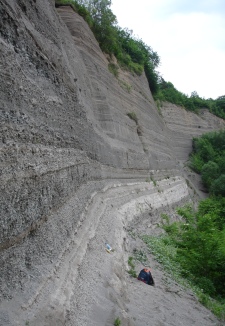

(Left): Section showing Laacher See tephra deposits; (middle): sampling the upper layers in the quarry section at Pulvermaar; (top right): helpful road sign; (middle right): view of Pulvermaar from air; (bottom right): our hotel (sorry, couldn't resist)
The Eifel is of particular interest to RESET because of its relevance to WP-3, which is investigating the re-population of Europe north of the Alps following the Last Glacial Stage (~20 ka). Tephra layers are found in archaeological sites from eastern Belgium and Germany, and so dating and geochemical fingerprinting of the proximal volcanic deposits from the Eifel should help to better constrain the timing of the Lateglacial human re-colonization process. Tephra layers are also found in high precision palaeoenvironmental records, such as lake and marine cores. Analysis of tephra layers in such records should help to constrain the timing and rate of abrupt environmental transitions and provide linkages between climate-induced and anthropogenic events.
WP-2 Fieldwork in North Africa
Dustin White and Nick Barton
Nick Barton, Dustin White, Anna Oh and the rest of the WP-2 team returned from another successful season of fieldwork at Grotte des Pigeons at Taforalt, Morocco (view from interior of cave, below). This season’s aims were to continue to collect palaeoenvironmental and dating evidence relating to the Iberomaurusian (Upper Palaeolithic) and Aterian (Middle Palaeolithic) levels of the cave. Samples very rich in microfauna, terrestrial molluscs and charcoal were recovered, as well as artefacts including examples of Nassarius (marine shell) beads from some of the earlier Aterian layers. The cave has already produced some very promising microtephra results which are currently being written up by Anna Oh.
April 2009
WP-4 Turkish Volcanoes
Martin Menzies
Several volcanic centres in Turkey are vital to RESET as they were associated with highly explosive eruptions, the result of either caldera-collapse or phreato(+water)-magmatic eruptions related to maar-formation involving felsic magmas. These result in widely dispersed tephras which are ideal for tephrochronology. In this visit several volcanic centres were targeted (discussed below, youngest to oldest).
Erciyes (8-10 ka) volcano (3917 metres) in southern Anatolia has several parasitic domes which have been prone to Vulcanian collapse and/or explosive failure. The fall deposits associated with the collapse of these domes are widely dispersed and occur in eastern Mediterranean cores (c.8-10 ka) as far south as Israel and toward Egypt (Yvonne Hammond PhD - ETH). Activity at these domes was recorded in wall paintings in the famous pre-pottery Neolithic settlement of Catal Hüyük in Anatolia. The main target for RESET are Karagullu (12-14 ka) and Perikartini (8-10 ka) on the northern slopes, and Dikkarrin (8-11 ka) on the south-east slopes. These have been dated by 14C and 36Cl measurements. RESET has samples from all three domes (8-14ka).
Nemrut (10 & 80 ka) volcano (2948 metres) in eastern Anatolia occurs close to the borders with Iran and Iraq. Fieldwork has logistical complexities, so thankfully samples were available at the University of Hacettepe due to recent research by Evren Çubukcu (Clermont-Ferrand PhD) and Inan Ulusoy (Hacettepe PhD) on the petrology, mineralogy and hydrothermal activity of Nemrut. Nemrut experienced caldera-collapse around 80-90 ka associated with the eruption of welded ignimbrite (i.e. hot) and fall deposits. Since that time intra-caldera activity has produced a variety of effusive and explosive products. RESET has samples from the caldera-forming eruptions (<80 ka) and the more recent intra-caldera (very fresh) surge deposits (<10 ka).
Acigol (20-30 ka) is a volcanic complex in NW Central Anatolia. In the Quaternary the Acigol field erupted two moderately sized pyroclastic deposits from vents possibly centred on Kocadag Tepe. The lower Acigol Tuff was formed during a pre-caldera eruption associated with rhyolite domes. In contrast a caldera-forming eruption produced the Upper Acigol Tuff followed by dome formation and maar-related eruptions. RESET has samples from the Acigol maar (c.20 ka) but more fieldwork is necessary to sample the Guneydag (12-20 ka), Korudagi (16 ka) and Kocadag (70 ka) domes.
Golcuk (50-72 ka) is a 2.5 km wide maar in the west of Turkey near the city of Isparta. The volcano went through a period of post-caldera dome growth followed by post-caldera maar-related Phreato-Plinian eruptions. These maar-related eruptions were associated with fall units dated using 40Ar/39Ar to 50 and 72 ka by Paul Renne at the Berkeley Geochronology Centre. Fieldwork is necessary to sample the uppermost pyroclastic deposits (50-72 ka).
As a result of this visit to Turkey RESET has been invited to collaborate with the University of Hacettepe on a drilling program in the Acigol maar part of the VAMP program (tectonics-exhumation). Hopefully these cores will provide a 20-30 ka record of volcanic activity and environmental change in a terrestrial site in the eastern Mediterranean region.
March 2009
WP-6 Core sampling in Greifswald, Germany
Christine Lane
Christine Lane and Vicky Cullen visited the University of Greifswald, to collect samples from Lateglacial lacustrine records from northeast Germany. Finding tephra horizons within the detailed palaeoenvironmental archives, provided by Martin Theuerkauf (Institute for Botany and Landscape Ecology), will extend the network of sites in Central Europe, which record the abrupt environmental transitions of the last glacial to interglacial transition. The lakes are also well located to compliment the archaeological sites being investigated within WP-3.
February 2009
WP-6 Core sampling in Zaragoza, Spain
Simon Blockley
Members of WP-6 have recently been sampling long core records, archived in the Instituto Pirenaico de Ecología-CSIC, Zaragoza, Spain. These samples will, we hope, tell us about tephra distribution into Spain during the late Quaternary. Spain is very important in the context of late Quaternary archaeology, being the latest reported area in western Europe for Neanderthal survival. Moreover, linking the climatic record of the Atlantic to the Mediterranean is an essential part of RESET core research. Testing the likelihood of tephra presence in this region is thus very important. Simon Blockley and (pictured from left) Mark Hardiman, Sharen Lee and Christine Lane, sampled cores from both east and western Spain that cover the RESET time frame.
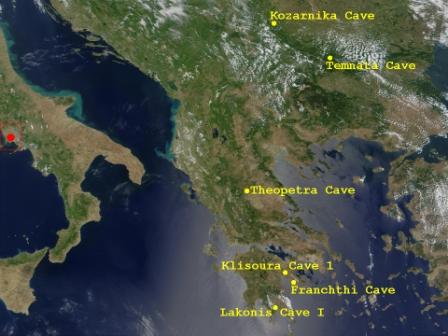

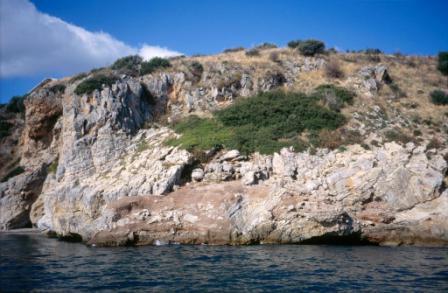


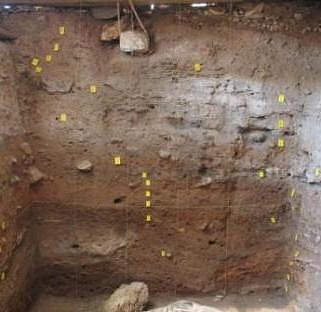

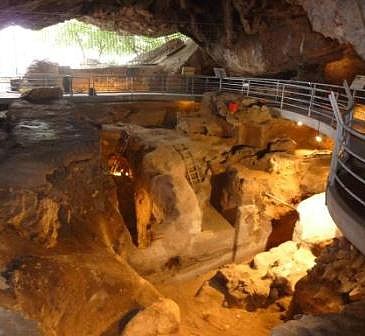
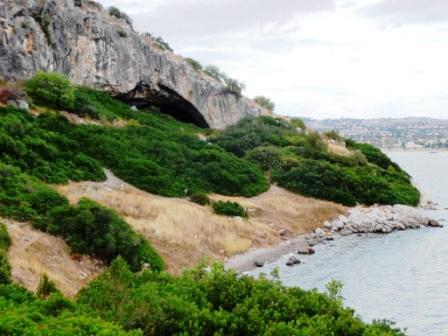
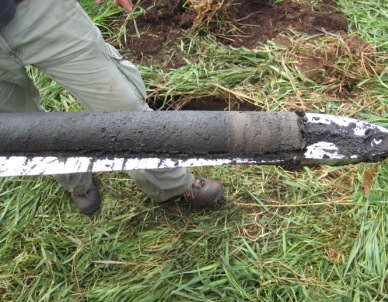
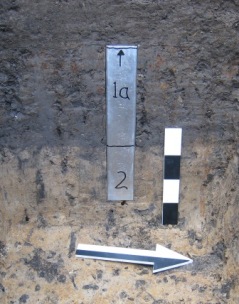







 (Left): cores from Padul peat bog awaiting sub-sampling for microtephra
(Left): cores from Padul peat bog awaiting sub-sampling for microtephra






 WP-4 is interested in the more recent intra-caldera activity of the Acigöl complex, the products of which are potentially important for dating eastern Mediterranean and south-eastern European marine cores and archaeological sites. We sampled several maars and associated rhyolite domes [Kocadag (~70 ka), Guneydag (12-20 ka), Korudagi (~16 ka)] which are relevant to RESET.
WP-4 is interested in the more recent intra-caldera activity of the Acigöl complex, the products of which are potentially important for dating eastern Mediterranean and south-eastern European marine cores and archaeological sites. We sampled several maars and associated rhyolite domes [Kocadag (~70 ka), Guneydag (12-20 ka), Korudagi (~16 ka)] which are relevant to RESET.

 In 2000 and 2001 a series of rescue investigations were undertaken near the town of Dourges in the Nord-Pas-de-Calais region of north-eastern France in advance of construction work connected with modern economic development. The field investigations uncovered a surviving Lateglacial sedimentary sequence with associated Magdalenian and Federmesser archaeology (including lithics and worked bone artefacts) and well-preserved malaeocological and vertebrate faunal remains (for an account of the work, see the paper by Deschodt et al., 2005.Quaternaire 16, 229-252).
In 2000 and 2001 a series of rescue investigations were undertaken near the town of Dourges in the Nord-Pas-de-Calais region of north-eastern France in advance of construction work connected with modern economic development. The field investigations uncovered a surviving Lateglacial sedimentary sequence with associated Magdalenian and Federmesser archaeology (including lithics and worked bone artefacts) and well-preserved malaeocological and vertebrate faunal remains (for an account of the work, see the paper by Deschodt et al., 2005.Quaternaire 16, 229-252).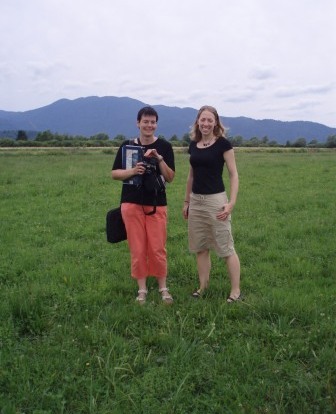
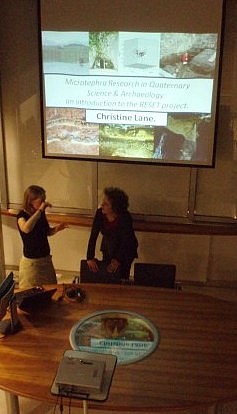





 Between 9-22nd May Chris Satow (PhD student, RHUL) and Jennifer Stanford (postdoctoral research assistant, NOCS) visited the Bremen Core Repository at the MARUM centre, University of Bremen to sample ODP core 975. During the sampling they were kindly assisted by Walter Hale, Ursula Rohl and Vera Lukies. The core was run through the scanning XRF facility to gain first order compositional data, logged and photographed, and sub-sampled with U-channels. The sub-samples will be subjected to a multitude of proxy extraction procedures and, of course, processed for potential microtephra.
Between 9-22nd May Chris Satow (PhD student, RHUL) and Jennifer Stanford (postdoctoral research assistant, NOCS) visited the Bremen Core Repository at the MARUM centre, University of Bremen to sample ODP core 975. During the sampling they were kindly assisted by Walter Hale, Ursula Rohl and Vera Lukies. The core was run through the scanning XRF facility to gain first order compositional data, logged and photographed, and sub-sampled with U-channels. The sub-samples will be subjected to a multitude of proxy extraction procedures and, of course, processed for potential microtephra. Pantelleria is the southernmost RESET eruptive site that lies in the (extensional) Sicily Channel between Sicily and Tunisia and is world-renowned for the occurence of pantellerite - a peralkaline rhyolites. Panellerite is a black, obsidian-like rock which was traded and utilised in the Mediterranean probably since pre-Christian times. Giovanni Orsi (INGV Naples) has mapped Pantelleria over the last 20+ years and kindly organised our excursion around the island between May 25-29th as part of the NERC RESET Consortium. Seven localities were selected focusing on the pre- and syn-caldera volcanic evolution of the island. Since the time window for RESET is 10-100 ka we were especially interested in the eruption of the Green Tuff (50 ka marker tephra) which blankets the pre-existent volcano and hence a large part of the island. It provides a very convenient and obvious time horizon and can be identified from some distance due to its colour and unconformable stratigraphy. The stratigraphy around the Green Tuff (50 ka) can be interpreted to mean that the eruption was relatively short lived producing a laterally continuous ignimbrite and co-ignimbrite ash layer layer. Since 50 ka was a "low stand" period in the Mediterranean the Green Tuff eruption would have produced sub-aerial flows that must exist beneath the present sea-level so a considerable amount of erupted fall and flow volume is submarine in nature.
Pantelleria is the southernmost RESET eruptive site that lies in the (extensional) Sicily Channel between Sicily and Tunisia and is world-renowned for the occurence of pantellerite - a peralkaline rhyolites. Panellerite is a black, obsidian-like rock which was traded and utilised in the Mediterranean probably since pre-Christian times. Giovanni Orsi (INGV Naples) has mapped Pantelleria over the last 20+ years and kindly organised our excursion around the island between May 25-29th as part of the NERC RESET Consortium. Seven localities were selected focusing on the pre- and syn-caldera volcanic evolution of the island. Since the time window for RESET is 10-100 ka we were especially interested in the eruption of the Green Tuff (50 ka marker tephra) which blankets the pre-existent volcano and hence a large part of the island. It provides a very convenient and obvious time horizon and can be identified from some distance due to its colour and unconformable stratigraphy. The stratigraphy around the Green Tuff (50 ka) can be interpreted to mean that the eruption was relatively short lived producing a laterally continuous ignimbrite and co-ignimbrite ash layer layer. Since 50 ka was a "low stand" period in the Mediterranean the Green Tuff eruption would have produced sub-aerial flows that must exist beneath the present sea-level so a considerable amount of erupted fall and flow volume is submarine in nature.





